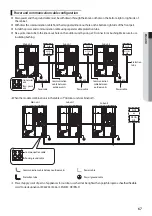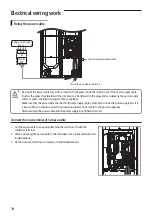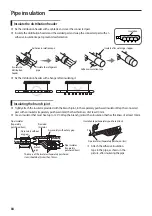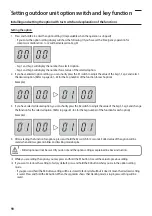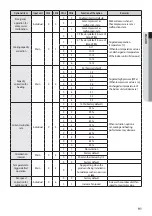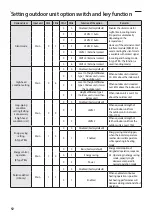
80
Air tightness test and vacuum drying
Air tightness test
f
Use tools for R-410A to prevent the inflow of foreign substances and resist against the internal pressure.
f
Do not remove the core of filling port.
f
Use Nitrogen gas for air tightness test as shown in the illustration.
H/P
H/R
Manifold gage
High pressure
side
Low pressure side
Filling
port
Gas
pipe
Liquid pipe
Nitr
ogen gas
Service valve
Manifold gage
High
pressure
side
Low pressure side
Filling
port
Gas
pipe
High pressure
gas pipe
Nitr
ogen gas
Service valve
Liquid
pipe
Apply pressure to the liquid side pipe and gas side pipe
(when installing outdoor units in module) with Nitrogen
gas at 4.1MPa.
If you apply pressure at more than 4.1MPa, pipes may get
damaged. Apply pressure with pressure regulator and pay
attention to the pressure of the nitrogen.
Keep it for minimum 24 hours to check if pressure drops.
After applying Nitrogen gas, check there's any change of
pressure, using a pressure regulator.
If the pressure drops, check for gas leakage.
If the pressure is changed, apply soap water to check for leakage
and check the pressure of the nitrogen gas again.
Maintain 1.0MPa of the pressure before performing
vacuum drying and check for further gas leakage.
After checking the first gas leakage, maintain 1.0MPa to check for
further gas leakage.
• Perform a Nitrogen gas leak test with the service valve of the outdoor unit closed.
• When charging the nitrogen gas, charge it from the both (high•low pressure) sides.
• If the pipe is filled in a short time with a highly excessive pressure of Nitrogen gas, the pipes may get damaged.
Make sure to use a regulator to prevent the high pressure Nitrogen gas, over 4.1MPa, from entering into the pipe.
CAUTION
Содержание DVM S AM080FXVAGH
Страница 112: ......


